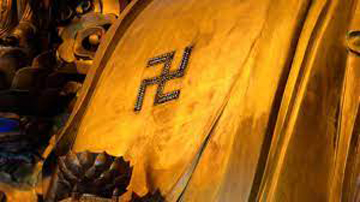
NEW JERSEY (TIP): Describing the Swastika as a “symbol of peace, well-being and prosperity,” the Hindu American Foundation (HAF) has asked its supporters to take action to stop Maryland and New Jersey legislators from banning its public display.
“The Maryland House of Delegates is considering House Bill 0418 (HB0418) a bill that falsely defines the swastika as a symbol of hate. TAKE ACTION TODAY TO STOP THIS,” it tweeted Saturday.
The New Jersey State Assembly is also “considering AB1749, a bill that would amend a state statute that criminalizes display of symbols, objects, or graffiti exposing another to threats of violence to specifically include swastikas,” it said in an earlier post.
The prominent Hindu group wants its supporters to email the Governors and state legislators in Maryland and New Jersey to urge them to oppose the two bills.
“The bills make no distinction between the Nazi emblem and the sacred history and meaning of the swastika for over two billion Hindus, Buddhists and Jains in the United States and around the world as a Sanskrit word and symbol of peace, well-being and prosperity,” it says.
While the Maryland bill “conflates the Nazi emblem or hooked cross with the swastika,” the New Jersey bill “tries to distinguish the Nazi emblem or hooked cross from the swastika by calling it the ‘Nazi swastika’” HAF says.
Noting the Nazi Party adopted the hooked cross (Hakenkreuz in German) as its emblem in 1920, HAF describes Nazism as “the hateful ideology that is responsible for the killing of millions of Jewish people and other innocents.
“The swastika, a Sanskrit word and symbol central to Hindu, Buddhist, and Jain spiritual life, invokes wellbeing and prosperity,” it said.
“It’s used in daily religious practice, special rites, and displayed in our homes, temples, and places of business. It may also be displayed in jewelry, clothing, and art,” HAF said.
“These two symbols, and their history and meanings are NOT the same and should not be conflated,” the Hindu group said.
“Imagine the shame and bullying our children could face as a result of the state’s mis-portrayal of the swastika. Imagine the devastating impact it could have on Hindu, Buddhist, and Jain families to freely practice their religion and pass traditions on to the next generation,” HAF said.
HAF also asked supporters to educate friends, neighbors, and colleagues and spread awareness about the ancient history and sacred significance of the swastika.
In Sanskrit, the word swastika is a combination of ‘su’ (meaning ‘good’) and ‘asti’ (meaning ‘to exist’), it said. Popularly, this gets translated as ‘all is well.’
“The swastika is thus understood to be a symbol of auspiciousness and good fortune, and is regularly donned on Hindu homes, businesses, printed materials, cars, temples, and ashrams,” HAF said. Many Hindus adorn the threshold of the front entrance to their homes with the swastika, it said noting, other faith traditions originating in India also regularly use the swastika, with similar auspicious meaning.
The swastika had a major resurgence of usage in Europe and North America in the 19th century as a good luck symbol, HAF said.
Prior to its appropriation by the Nazis, swastikas appeared on Coca-Cola and beer bottles, it said. The Boy Scouts in the US and other scouting groups in Europe used swastikas on badges.
“To this day, there is a town of Swastika, Ontario, Canada, founded in 1908,” HAF said.
“The US Army’s 45th infantry division used it as a sleeve insignia during the 1920s up until the rise of the Nazis. The UK’s Royal Air Force had it on planes up until 1939.”





Be the first to comment